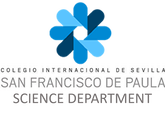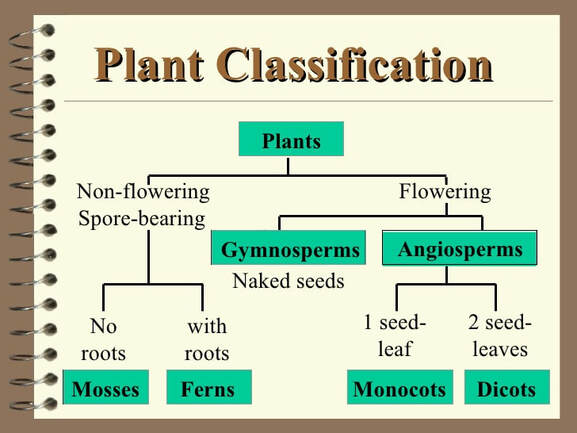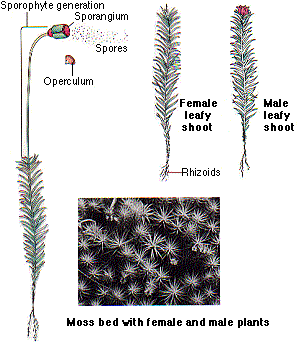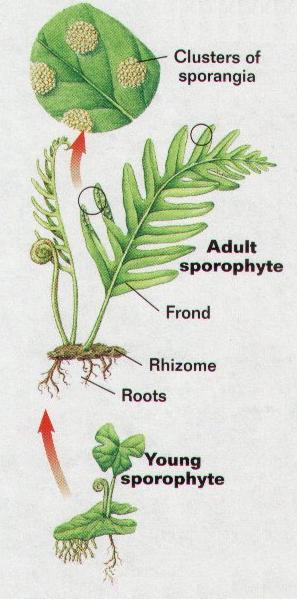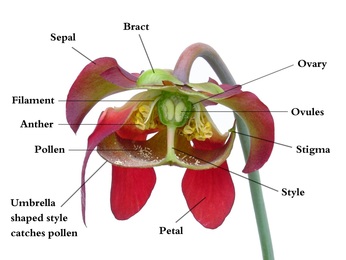Kingdom Plantae
Key words
feature bryophytes herbaceous node
to release pteridophytes sporangium, leaf (leaves)
damp gymnosperms vascular apix
cluster angiosperms rhizome sepal
shrub tropism fronds calyx
to burst nastic sorus, -i corolla
petal stamen filament anther
carpel or pistal stigma style ovary,-ies to fuse
ovule gamete zygote fleshy
ripe
to release pteridophytes sporangium, leaf (leaves)
damp gymnosperms vascular apix
cluster angiosperms rhizome sepal
shrub tropism fronds calyx
to burst nastic sorus, -i corolla
petal stamen filament anther
carpel or pistal stigma style ovary,-ies to fuse
ovule gamete zygote fleshy
ripe
1. What Is a Plant?
Plants or metaphytes are, autotrophic multicellular eukaryotes, with tissues.
Besides these main characteristics, plants all have similar physical features that make them easily recognizable.
- Plants are multicellular, they are made of many cells.
- They are eukaryotes; their cells have a defined nucleus in the cytoplasm.
- They have tissues; their cells are specialised into tissues, organs (such as leaves, roots or flowers) and systems.
- They are autotrophs; they make their own food by photosynthesis.
Besides these main characteristics, plants all have similar physical features that make them easily recognizable.
- They have roots, stem and leaves, even though their shape may vary from one species to another.
- They are green due to the presence of chlorophyll; a photosynthetic pigment.
Classification of Plants
Plants are classified into 4 groups: bryophytes or mosses, pteridophytes or ferns, gymnosperms and angiosperms.
|
2.1 Mosses and liverworts (Bryophytes)
Mosses and liverworts (Bryophytes) are the simplest plants. They are small, with no true vascular tissues, flowers nor fruits. |
2.2 Ferns (Pteridophytes)
Ferns (Pteridophytes) are medium sized plants with true vascular tissues. They don’t have flowers nor fruits. |
2.3 Gymnosperms
Gymnosperms or conifers are plants with vascular tissues but without fruits.
They are trees or shrubs, mostly evergreen and they grow in different climates. However most of the species are found in colder climates and at higher altitudes than other trees. The features of a conifer are the following:
Conifers reproduce sexually. The male cones of conifers produce pollen. The pollen is distributed by wind reaching the female cones. Once fertilization takes place, the female cone develops into a pine cone. The fertilized pine (female) cones grow seeds (pine seeds) which will eventually give rise to new plants.
Gymnosperms or conifers are plants with vascular tissues but without fruits.
They are trees or shrubs, mostly evergreen and they grow in different climates. However most of the species are found in colder climates and at higher altitudes than other trees. The features of a conifer are the following:
- They have softwoods.
- They have needle-like leaves covered by a very thick cuticle which prevents water loss.
- The seeds are not enclosed in an ovary. Their seeds are ‘naked’, without protection from a fruit, in a cone.
Conifers reproduce sexually. The male cones of conifers produce pollen. The pollen is distributed by wind reaching the female cones. Once fertilization takes place, the female cone develops into a pine cone. The fertilized pine (female) cones grow seeds (pine seeds) which will eventually give rise to new plants.
Angiosperms
Angiosperms or flowering plants have vascular tissues, flowers and fruits.
Angiosperms are the most successful of plants. We can find an enormous variety of them, and they are the largest group. They have evolved into many species and adapted to all habitats
Flowering plants share the following general characteristics:
Flowering plants also reproduce sexually. The pollen is transported by insects or distributed by the wind from flower to flower. After a flower is fertilized, the fruit is formed in which the seeds are enclosed.
Angiosperms or flowering plants have vascular tissues, flowers and fruits.
Angiosperms are the most successful of plants. We can find an enormous variety of them, and they are the largest group. They have evolved into many species and adapted to all habitats
Flowering plants share the following general characteristics:
- They have efficient, well developed vascular tissues.
- They have broad leaves well adapted for photosynthesis.
- They have bright colourful flowers.
- Their seeds are enclosed in a fruit.
Flowering plants also reproduce sexually. The pollen is transported by insects or distributed by the wind from flower to flower. After a flower is fertilized, the fruit is formed in which the seeds are enclosed.
3. More About Plants
3.1. Roots, stems and leaves
Roots: Subterranean organs. They anchor the plant, absorb water, mineral salts and other nutrients from the soil. They are also a reservoir for food.
The stem: Aerial organ. It keeps the plant upright, and the different organs together. It also transports substances throughout the plant.
Stems (shoots) can be herbaceous, if they are soft, or woody if they are hard. (The stem divides into branches where we can see nodes; small bumps from which other branches, leaves, flowers or fruits can develop. The space between nodes is known as internode. At the nodes and apix of the stems there are buds. From buds new leaves and branches are formed).
Leaves: Laminated green organs where photosynthesis takes place and gas exchange occurs.
3.1. Roots, stems and leaves
Roots: Subterranean organs. They anchor the plant, absorb water, mineral salts and other nutrients from the soil. They are also a reservoir for food.
The stem: Aerial organ. It keeps the plant upright, and the different organs together. It also transports substances throughout the plant.
Stems (shoots) can be herbaceous, if they are soft, or woody if they are hard. (The stem divides into branches where we can see nodes; small bumps from which other branches, leaves, flowers or fruits can develop. The space between nodes is known as internode. At the nodes and apix of the stems there are buds. From buds new leaves and branches are formed).
Leaves: Laminated green organs where photosynthesis takes place and gas exchange occurs.
|
3.2. Photosynthesis and plant nutrition
Plants are autotrophs. They manufacture their own food by the process of photosynthesis. They take inorganic compounds from the soil and the air, and with the energy from sunlight transform them into organic substances (sugars) |
|
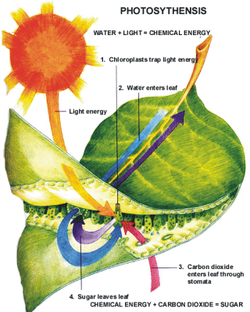
- Plants take water and mineral salts from the soil through their roots. This mixture is called raw sap.
- Raw sap is transported up the stem to the leaves through vascular bundles
- The leaves take carbon dioxide from the air, and through the process of photosynthesis, using the energy form sunlight, they transform the raw sap into elaborated sap. This elaborated sap contains nutrients (sugars = glucids).
- The elaborated sap is transported to the rest of the plant also through vascular tissues, and to the roots for storage.
Photosynthesis: process by which plants elaborate organic substances from simple inorganic substances, like water, and carbon dioxide, using sunlight. The organic substances elaborated during this process are simple sugars like glucose. During the process of photosynthesis, oxygen (O2) is released as a waste product.
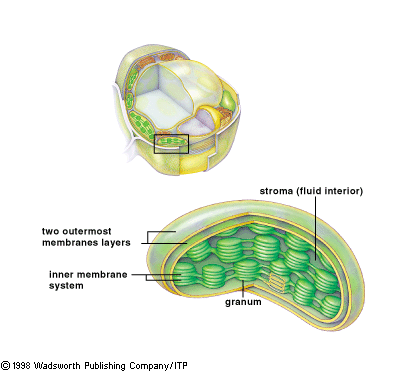
The simple sugars manufactured during photosynthesis will be used by the cells to make other substances.
3.4 Respiration in plants
Plants, just like any other living organism, also respire. During respiration, the gas exchange is exactly the opposite as in photosynthesis. Oxygen is taken in and carbon dioxide is expelled as a waste product. Plants always respire.
Plants carry out photosynthesis and respiration during day time, and only respiration at night time.
Plants, just like any other living organism, also respire. During respiration, the gas exchange is exactly the opposite as in photosynthesis. Oxygen is taken in and carbon dioxide is expelled as a waste product. Plants always respire.
Plants carry out photosynthesis and respiration during day time, and only respiration at night time.
3.5 How plants interact and respond to their environment
Plants, like all living things, are sensitive to their environment. Since plants are non-motile, they respond to different stimuli by changing their growth patterns.
A positive response is when the plant moves towards the stimulus. And a negative response is when the plant moves away from the stimulus. Some of the responses to stimuli are temporary movements while others are definite changes.
Tropisms are permanent changes in a plant’s growth: ex. when a plant grows towards or away from light it is phototropism. A positive geotropism is when the root tries to find soil.
Nastics are temporary changes that have nothing to do with their growth; such as plants that follow the sun, or open (up) during the day and close at night.
Plants, like all living things, are sensitive to their environment. Since plants are non-motile, they respond to different stimuli by changing their growth patterns.
A positive response is when the plant moves towards the stimulus. And a negative response is when the plant moves away from the stimulus. Some of the responses to stimuli are temporary movements while others are definite changes.
Tropisms are permanent changes in a plant’s growth: ex. when a plant grows towards or away from light it is phototropism. A positive geotropism is when the root tries to find soil.
Nastics are temporary changes that have nothing to do with their growth; such as plants that follow the sun, or open (up) during the day and close at night.
Click here to play a respiration game and here to check your knowledge.
|
|
|
4. Plants Reproduction
Plants can reproduce asexually or sexually.
In asexual reproduction only one individual plant takes part. Asexual reproduction in plants is also known as vegetative propagation. Stem cuttings are a form of artificial propagation.
In sexual reproduction two sex cells of opposite sex (a female and a male sex cell) are involved. Inside the flower sex cells, called gametes, are produced. The male gametes are in the pollen of the flower, while the female gametes are in the ovary of the flower. After fertilization seeds develop, being able to grow into a new plant.
Plants can reproduce asexually or sexually.
In asexual reproduction only one individual plant takes part. Asexual reproduction in plants is also known as vegetative propagation. Stem cuttings are a form of artificial propagation.
In sexual reproduction two sex cells of opposite sex (a female and a male sex cell) are involved. Inside the flower sex cells, called gametes, are produced. The male gametes are in the pollen of the flower, while the female gametes are in the ovary of the flower. After fertilization seeds develop, being able to grow into a new plant.
|
The flower of an angiosperm (LINK TO ANIMATION)
The flower is the reproductive organ system in angiosperms. The flower of an angiosperm is formed by the following parts:
|
|
- The carpel or pistil (gynaecium) is the female reproductive organ of the flower. Its shape resembles that of a small bottle with an elongate neck and it is at the centre of the flower. The carpel consists of the stigma, the style and the ovary. The ovary contains the ovules, which contains the female gametes.
4.2. Pollination
In order for sexual reproduction to take place, the male gametes and the female gametes must meet. This is done by a process know as pollination.
Pollination is the transfer of pollen grains, containing the male sex cells (gametes), to the female flower parts, containing the female sex cells (gametes)
We can differentiate between self-pollination and cross-pollination. In self-pollination, the transfer of gametes takes place within the same flower. However, if the transfer takes place between two different flowers (from one flower to another) of the same species, we call it cross pollination.
Pollination is carried out by the wind or animals (usually insects but also some birds species such as hummingbirds)
In order for sexual reproduction to take place, the male gametes and the female gametes must meet. This is done by a process know as pollination.
Pollination is the transfer of pollen grains, containing the male sex cells (gametes), to the female flower parts, containing the female sex cells (gametes)
We can differentiate between self-pollination and cross-pollination. In self-pollination, the transfer of gametes takes place within the same flower. However, if the transfer takes place between two different flowers (from one flower to another) of the same species, we call it cross pollination.
Pollination is carried out by the wind or animals (usually insects but also some birds species such as hummingbirds)
4.3. Fertilization
Fertilization is the step that follows pollination. Once the grain of pollen has landed on the stigma of a flower, pollination is complete.
Now that the pollen grain is in the stigma of the flower, it grows a pollen tube that goes down the style. Eventually, the pollen tube will reach the ovary.
Once inside the ovary, the pollen tube opens up allowing the male sex cells move down and into the ovary where it will fuse with the female sex cell forming a zygote.
The zygote will turn into an embryo, which will be enclosed in a seed..
Fertilization is the step that follows pollination. Once the grain of pollen has landed on the stigma of a flower, pollination is complete.
Now that the pollen grain is in the stigma of the flower, it grows a pollen tube that goes down the style. Eventually, the pollen tube will reach the ovary.
Once inside the ovary, the pollen tube opens up allowing the male sex cells move down and into the ovary where it will fuse with the female sex cell forming a zygote.
The zygote will turn into an embryo, which will be enclosed in a seed..
4.4 The formation of seed and fruit
After fertilization takes place, the flower undergoes a few changes.
After fertilization takes place, the flower undergoes a few changes.
- The sepals and petals dry up and usually fall off.
- The stamen, the stigma and the style also dry up (wither away), being left only the ovary, which grows and changes in colour. It has now become the fruit.
- If the fruit contains lots of water such as an apple, a peach, a cherry, a grape etc., it is called a fleshy fruit.
- However, if the fruit has little water and it becomes hardened such as peanuts, acorns, beans etc., it is called a dry fruit.
4.5 Germination of seeds
When the fruit is ripe, it falls to the ground eventually releasing the seeds. Shortly after that, if the environmental conditions are good, the seed will germinate.
The seed needs the following to germinate: a water supply, oxygen and a suitable temperature.
During germination, the seed absorbs lots of water swelling up until bursting (splitting open) of the outer coat. Once the outer coat splits open the new plant begins to grow.
When the fruit is ripe, it falls to the ground eventually releasing the seeds. Shortly after that, if the environmental conditions are good, the seed will germinate.
The seed needs the following to germinate: a water supply, oxygen and a suitable temperature.
During germination, the seed absorbs lots of water swelling up until bursting (splitting open) of the outer coat. Once the outer coat splits open the new plant begins to grow.
References:
